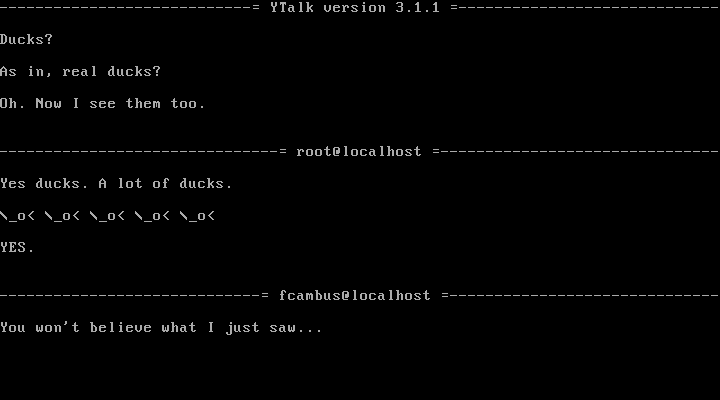Talk and ytalk nostalgia
Frederic Cambus June 20, 2016 [Miscellaneous]It recently occurred to me that I have been using modems for more than 20 years now. How time flies... That got me thinking about my early modem days, calling BBSes in what was then my local area (Toulouse, France). One of the best memories I have from the BBS era is without doubt split-screen chatting.
This mode of chatting has something magical in the sense that you can see characters appear on screen as soon as the person on the other side of the line types them. You can see cursor movements, typos being corrected, pauses, and hesitations... It conveys emotions better. This is something IRC and modern chat programs failed to emulate.
I used this mode of chatting on MS-DOS BBSes but most importantly on Linux based BBSes. In retrospect, I consider myself lucky to have had access to a couple of Linux servers available via dialup. There were three of them in Toulouse: "BarbeRouge", "Polux", and "Elfix". I was a frequent user on the first two systems of this list. For the record, if my memory serves me well, BarbeRouge was running on Red Hat, and Polux on Slackware. Chatting with the sysops was done using talk or ytalk.
Of course, it's still possible to run those programs nowadays, and in fact, I recently started using them again with friends.
On OpenBSD, it's as easy as enabling the ntalk daemon in /etc/inetd.conf:
ntalk dgram udp wait root /usr/libexec/ntalkd ntalkd
And enabling and starting inetd:
rcctl enable inetd
rcctl start inetd
Also make sure that that there is a correct entry with the machine hostname in /etc/hosts.
This is how a talk session looks like:

A ytalk session, showing a conversation between three users:

To this day, I still miss the glory of split-screen chatting sessions. I'm looking forward to revisiting this experience in the future. And thinking about the past, it was a fun way to see who typed fast and more accurately.